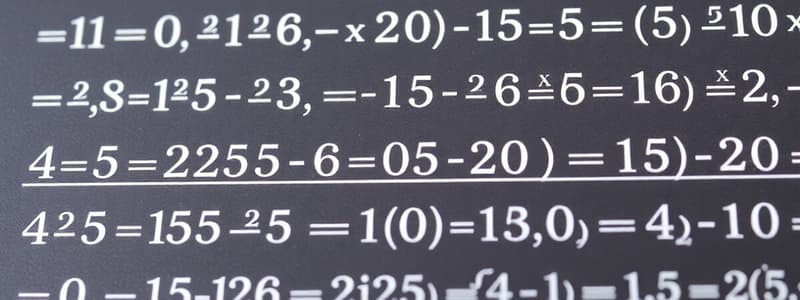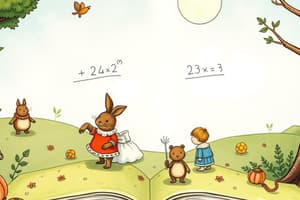Podcast
Questions and Answers
What is the algebraic sum of -34 and 18?
What is the algebraic sum of -34 and 18?
- 16
- -16 (correct)
- 52
- -52
What is the product of 7 and -5?
What is the product of 7 and -5?
- 35
- -35 (correct)
- 12
- -12
What is the quotient of -24 divided by -6?
What is the quotient of -24 divided by -6?
- 144
- -144
- -4
- 4 (correct)
If you subtract -10 from 25, what is the result?
If you subtract -10 from 25, what is the result?
What is the algebraic sum of -5, 10, and -2?
What is the algebraic sum of -5, 10, and -2?
What prefix would you use to denote one millionth of a unit?
What prefix would you use to denote one millionth of a unit?
If you have a value expressed in centi-units, how would you convert it to base units?
If you have a value expressed in centi-units, how would you convert it to base units?
Which prefix represents a factor of $10^{-9}$?
Which prefix represents a factor of $10^{-9}$?
What is a fraction in its lowest terms?
What is a fraction in its lowest terms?
Which of the following expresses one-tenth as a decimal?
Which of the following expresses one-tenth as a decimal?
If you divide a number into 1,000 equal parts, each part represents which fraction of the number?
If you divide a number into 1,000 equal parts, each part represents which fraction of the number?
How would you express 0.000001 in terms of prefixes?
How would you express 0.000001 in terms of prefixes?
Which of the following prefixes indicates a factor of $10^{1}$?
Which of the following prefixes indicates a factor of $10^{1}$?
What must be done to the decimal in the dividend when the decimal in the divisor is moved to convert it into a whole number?
What must be done to the decimal in the dividend when the decimal in the divisor is moved to convert it into a whole number?
What is the dividend in the calculation of 37.26 divided by 2.7?
What is the dividend in the calculation of 37.26 divided by 2.7?
If the multiplicand is 26.757 and the multiplier is 0.32, what is the first step to set up the multiplication?
If the multiplicand is 26.757 and the multiplier is 0.32, what is the first step to set up the multiplication?
After calculating 26.757 x 0.32, how many decimal places should be counted to set the decimal point in the product?
After calculating 26.757 x 0.32, how many decimal places should be counted to set the decimal point in the product?
What is the decimal result of 37.26 divided by 2.7?
What is the decimal result of 37.26 divided by 2.7?
When multiplying 26.757 by 0.32, which operation is performed first?
When multiplying 26.757 by 0.32, which operation is performed first?
What is the role of the divisor in the equation of 37.26 divided by 2.7?
What is the role of the divisor in the equation of 37.26 divided by 2.7?
What happens to the decimal when converting 2.7 into a whole number?
What happens to the decimal when converting 2.7 into a whole number?
What is the main purpose of the document mentioned?
What is the main purpose of the document mentioned?
Which regulatory requirements does the document fulfill?
Which regulatory requirements does the document fulfill?
What is prohibited regarding the training documents?
What is prohibited regarding the training documents?
Who owns the rights to the training documents?
Who owns the rights to the training documents?
What is the significance of the 'Rev.-ID: 1APR2023' notation?
What is the significance of the 'Rev.-ID: 1APR2023' notation?
What type of training does this document relate to?
What type of training does this document relate to?
What does the abbreviation 'AU' refer to in this document?
What does the abbreviation 'AU' refer to in this document?
What is clearly indicated in the training materials concerning their use?
What is clearly indicated in the training materials concerning their use?
What is the SI unit for length?
What is the SI unit for length?
Which of the following defines the meter since 1983?
Which of the following defines the meter since 1983?
How many millimeters are in one meter according to the decimal system?
How many millimeters are in one meter according to the decimal system?
Which system of measurement is not commonly used in the US for length?
Which system of measurement is not commonly used in the US for length?
What is the relationship between meters and kilometers?
What is the relationship between meters and kilometers?
The original definition of the meter used in 1799 was based on which measurement?
The original definition of the meter used in 1799 was based on which measurement?
Which of the following is a natural constant used to define basic units?
Which of the following is a natural constant used to define basic units?
What does 1 meter consist of in terms of decimeters, centimeters, and millimeters?
What does 1 meter consist of in terms of decimeters, centimeters, and millimeters?
What is the first step when multiplying fractions if there are common factors in the numerator and denominator?
What is the first step when multiplying fractions if there are common factors in the numerator and denominator?
What does the word 'of' indicate in problems involving fractions?
What does the word 'of' indicate in problems involving fractions?
Calculate the result of multiplying the fractions $\frac{2}{3}$ and $\frac{5}{7}$ and then simplifying the final answer.
Calculate the result of multiplying the fractions $\frac{2}{3}$ and $\frac{5}{7}$ and then simplifying the final answer.
What is the equivalent of multiplying $\frac{3}{8}$ by $\frac{5}{8}$?
What is the equivalent of multiplying $\frac{3}{8}$ by $\frac{5}{8}$?
If we have the expression $\frac{1}{3} \cdot \frac{5}{1}$, what is the outcome when simplified?
If we have the expression $\frac{1}{3} \cdot \frac{5}{1}$, what is the outcome when simplified?
What is the final result of multiplying $\frac{2}{5}$ by $\frac{21}{32}$ after canceling common factors?
What is the final result of multiplying $\frac{2}{5}$ by $\frac{21}{32}$ after canceling common factors?
In the multiplication of $\frac{3}{8}$ and $\frac{7}{11}$, what is the common factor canceled?
In the multiplication of $\frac{3}{8}$ and $\frac{7}{11}$, what is the common factor canceled?
What is the equivalent decimal form of the fraction $\frac{5}{16}$?
What is the equivalent decimal form of the fraction $\frac{5}{16}$?
Flashcards
Document Compliance
Document Compliance
This document meets the standards set by the "DGCA KCASR 1 Part 66 Appendix I" and is approved for use at AU.
Training Focus
Training Focus
This training manual covers fundamental mathematics relevant to cabin base electrician/mechanics.
International Standards
International Standards
This manual is aligned with the requirements of EASA Part-66, UAE GCAA CAR 66, and CAAS SAR-66.
Training Category
Training Category
Signup and view all the flashcards
Specific Training Unit
Specific Training Unit
Signup and view all the flashcards
Export Control
Export Control
Signup and view all the flashcards
Copyright Ownership
Copyright Ownership
Signup and view all the flashcards
Copyright Restrictions
Copyright Restrictions
Signup and view all the flashcards
Algebraic sum
Algebraic sum
Signup and view all the flashcards
Multiplying signed numbers: negative x negative
Multiplying signed numbers: negative x negative
Signup and view all the flashcards
Multiplying signed numbers: positive x negative
Multiplying signed numbers: positive x negative
Signup and view all the flashcards
Subtracting signed numbers
Subtracting signed numbers
Signup and view all the flashcards
Dividing signed numbers
Dividing signed numbers
Signup and view all the flashcards
Dividing signed numbers: negative / negative
Dividing signed numbers: negative / negative
Signup and view all the flashcards
Dividing signed numbers: positive / negative
Dividing signed numbers: positive / negative
Signup and view all the flashcards
Dividing signed numbers: negative / positive
Dividing signed numbers: negative / positive
Signup and view all the flashcards
Dividend
Dividend
Signup and view all the flashcards
Divisor
Divisor
Signup and view all the flashcards
Quotient
Quotient
Signup and view all the flashcards
Decimal shifting in division
Decimal shifting in division
Signup and view all the flashcards
Decimal places
Decimal places
Signup and view all the flashcards
Product
Product
Signup and view all the flashcards
Multiplicand
Multiplicand
Signup and view all the flashcards
Multiplier
Multiplier
Signup and view all the flashcards
Multiplying Fractions
Multiplying Fractions
Signup and view all the flashcards
Simplifying Fractions Before Multiplication
Simplifying Fractions Before Multiplication
Signup and view all the flashcards
The Word 'of' in Fractions
The Word 'of' in Fractions
Signup and view all the flashcards
Complex Fraction
Complex Fraction
Signup and view all the flashcards
Common Fraction
Common Fraction
Signup and view all the flashcards
Lowest Terms
Lowest Terms
Signup and view all the flashcards
Metric Prefix
Metric Prefix
Signup and view all the flashcards
Kilo (k)
Kilo (k)
Signup and view all the flashcards
Centi (c)
Centi (c)
Signup and view all the flashcards
Deci (d)
Deci (d)
Signup and view all the flashcards
Micro (µ)
Micro (µ)
Signup and view all the flashcards
Nano (n)
Nano (n)
Signup and view all the flashcards
Meter (m)
Meter (m)
Signup and view all the flashcards
Decimal System for Length
Decimal System for Length
Signup and view all the flashcards
Speed of Light
Speed of Light
Signup and view all the flashcards
Meridian Quadrant
Meridian Quadrant
Signup and view all the flashcards
Prototype Meter
Prototype Meter
Signup and view all the flashcards
Foot (ft)
Foot (ft)
Signup and view all the flashcards
Measures
Measures
Signup and view all the flashcards
Units
Units
Signup and view all the flashcards
Study Notes
Document Details
- Document satisfies DGCA KCASR 1 Part 66 Appendix I requirements
- Approved for use at AU (Australian University)
Course Details
- Fundamentals M1 Mathematics
- Compliant with EASA Part-66, UAE GCAA CAR 66, CAAS SAR-66
- Category B1/B2
- Rev.-ID: 1APR2023
- Author: SCP
- OLTT Release: Jun. 9, 2023
Training Manual
- Copyright by Lufthansa Technical Training GmbH (LTT)
- For training purposes and internal use only
- Does not contain Export Administration Regulations (EAR) controlled information
Studying That Suits You
Use AI to generate personalized quizzes and flashcards to suit your learning preferences.




